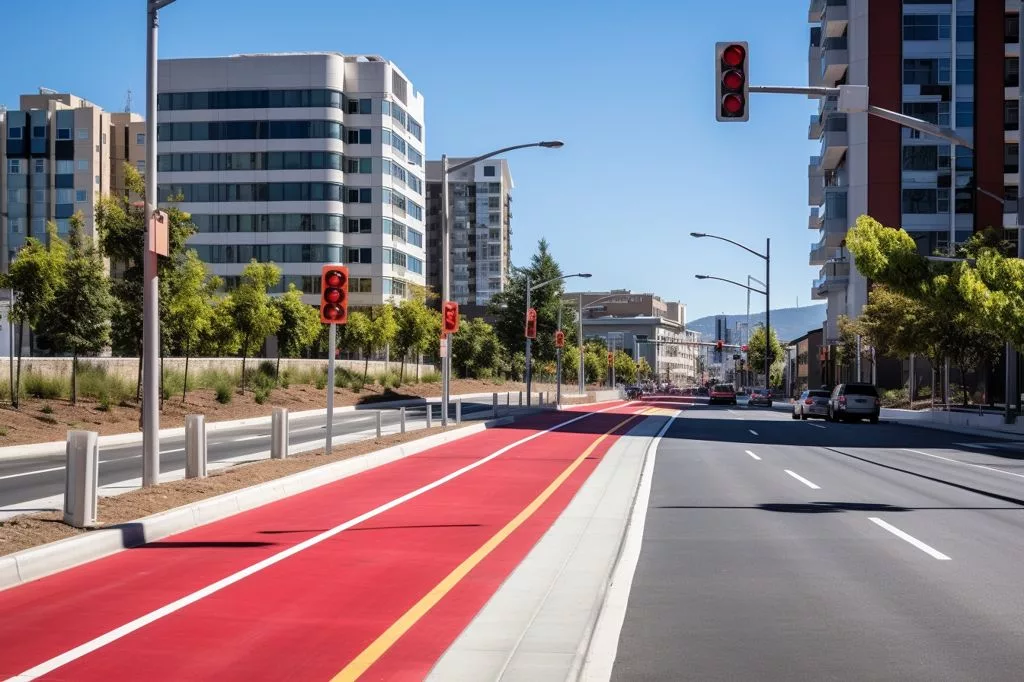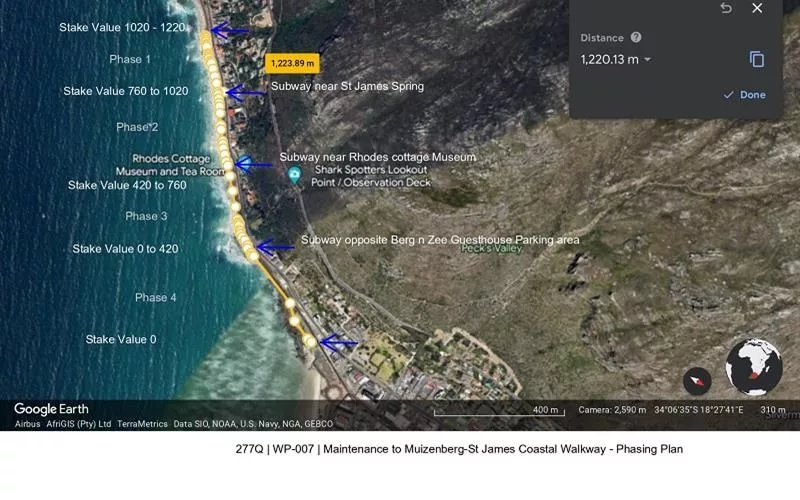The city of Cape Town is planning a resurfacing and revitalization project for Symphony Way, a primary artery in the Belhar suburb. The project aims to improve safety and accessibility for residents and businesses while ensuring the longevity of the road. It will include installing new kerb, channel, and footway sections, rebuilding base layers using cold in-situ recycled material, removing the existing surface and replacing it with hot-mix asphalt, and re-establishing traffic lights at intersections and reinstating road markings. The project is scheduled to begin on October 16, 2023, and aims for completion by December 4, 2023. Despite the temporary inconveniences, the project’s long-term advantages will improve the daily lives of those who use it.
What are the objectives of the Symphony Way road resurfacing project in Belhar, Cape Town?
The primary objectives of the Symphony Way road resurfacing and revitalization project in Belhar, Cape Town, are to improve safety and accessibility for residents and businesses while ensuring the longevity of the crucial artery. The project will include installing new kerb, channel, and footway sections, rebuilding base layers using cold in-situ recycled material, removing the existing surface and replacing it with hot-mix asphalt, and re-establishing traffic lights at intersections and reinstating road markings.
Breathing New Life into Symphony Way
Belhar, a lively suburb of Cape Town, South Africa, is presently undergoing a considerable infrastructure enhancement. Symphony Way, a primary artery in the area, is scheduled for an extensive resurfacing and revitalization project, as declared by the City of Cape Town’s Urban Mobility Directorate. Ranging from Erica Drive to the Stellenbosch Arterial, this crucial initiative is set to begin on October 16, 2023, and aims for completion by December 4, 2023, assuming favorable weather conditions and the absence of unexpected complications.
The project’s primary objectives are to improve safety and accessibility for Belhar’s residents and businesses while ensuring the longevity of this critical route. To minimize disruptions, work will take place on weekdays between 09:00 and 15:30, and if necessary, on weekends from 08:00 to 18:00.
Integral Elements of the Project
The upgrade of Symphony Way will incorporate several crucial elements, including:
- Installing new kerb, channel, and footway sections
- Rebuilding base layers utilizing cold in-situ recycled material
- Removing the existing surface, which will be replaced with hot-mix asphalt
- Re-establishing traffic lights at intersections and reinstating road markings eradicated during the resurfacing process
While these enhancements promise a safer and smoother driving experience, the ongoing construction will inevitably affect traffic on both sides of Symphony Way. Road users should expect partial road closures, congestion, and a Stop/Go system controlling traffic around the work zones. Detour traffic accommodation methods will also be employed to assist with vehicle flow. Consequently, commuters should consider alternative routes to avoid delays, if possible.
The Significance of Routine Maintenance
The Belhar resurfacing initiative exemplifies the City’s dedication to preserving and improving its vast road network. By investing in regular maintenance and upgrades, the City not only guarantees the safety of its citizens but also promotes economic growth and development in the region. A well-maintained infrastructure is crucial for the seamless movement of people, goods, and services, ultimately resulting in an enhanced quality of life for residents and businesses in the area.
Councillor Rob Quintas, the City’s Mayoral Committee Member for Transport, expressed optimism that the outcome of this project would be met with approval from the Belhar community. “I am confident that residents and businesses in this area will be quite satisfied with the smooth road surface that will follow this work,” Quintas said. Meanwhile, he encouraged road users to exercise caution and obey temporary road signs until the project’s completion.
Exploring the Resurfacing Technique
The utilization of cold in-situ recycled material in this project merits special attention. Cold in-situ recycling is an innovative and cost-effective approach to road rehabilitation, wherein the existing pavement materials are recycled on-site without the need for heat or additional aggregates. This eco-friendly method reduces waste produced during construction while also decreasing energy consumption associated with conventional road resurfacing techniques.
Likewise, the use of hot-mix asphalt in the project underscores the City’s commitment to employing high-quality materials and best practices in road construction. Hot-mix asphalt is favored for its durability and resistance to wear and tear, making it an ideal choice for busy thoroughfares such as Symphony Way.
The Wider Implications for Belhar and Beyond
Although the Symphony Way resurfacing project is focused on a local level, it serves as a reminder of the broader importance of continuous infrastructure maintenance and upgrades. As urban centers around the world persist in growing and developing, the demand for sustainable and dependable transportation networks becomes increasingly crucial. By investing in projects like this, local governments can guarantee the safety, effectiveness, and longevity of their road systems, ultimately benefiting both residents and businesses.
Belhar’s Symphony Way update showcases the power of foresight and planning. The anticipated outcome—a safer, smoother, and more durable artery—will undoubtedly improve the daily lives of those who use it. While the project’s completion may entail temporary inconveniences, the long-term advantages will undoubtedly resonate with the Belhar community and beyond.
What are the working hours for the Symphony Way road resurfacing project?
The working hours for the Symphony Way road resurfacing project in Belhar, Cape Town, are weekdays between 09:00 and 15:30 and, if necessary, on weekends from 08:00 to 18:00.
What are the integral elements of the Symphony Way project in Belhar?
The integral elements of the Symphony Way project in Belhar include installing new kerb, channel, and footway sections, rebuilding base layers using cold in-situ recycled material, removing the existing surface, which will be replaced with hot-mix asphalt, re-establishing traffic lights at intersections, and reinstating road markings eradicated during the resurfacing process.
How long will the Symphony Way road resurfacing project take?
The Symphony Way road resurfacing project is scheduled to begin on October 16, 2023, and aims for completion by December 4, 2023, assuming favorable weather conditions and the absence of unexpected complications.
What are the benefits of cold in-situ recycled material?
Cold in-situ recycled material is an innovative and cost-effective approach to road rehabilitation, wherein the existing pavement materials are recycled on-site without the need for heat or additional aggregates. This eco-friendly method reduces waste produced during construction while also decreasing energy consumption associated with conventional road resurfacing techniques.
Why is regular maintenance crucial for infrastructure?
Regular maintenance is crucial for infrastructure as it guarantees the safety of its citizens while promoting economic growth and development in the region. A well-maintained infrastructure is crucial for the seamless movement of people, goods, and services, ultimately resulting in an enhanced quality of life for residents and businesses in the area.
What is the significance of hot-mix asphalt?
Hot-mix asphalt is favored for its durability and resistance to wear and tear, making it an ideal choice for busy thoroughfares such as Symphony Way.
How will the ongoing construction affect traffic on Symphony Way?
Road users should expect partial road closures, congestion, and a Stop/Go system controlling traffic around the work zones. Detour traffic accommodation methods will also be employed to assist with vehicle flow. Consequently, commuters should consider alternative routes to avoid delays, if possible.
What is the wider implication of the Symphony Way project?
The Symphony Way project serves as a reminder of the broader importance of continuous infrastructure maintenance and upgrades. By investing in projects like this, local governments can guarantee the safety, effectiveness, and longevity of their road systems, ultimately benefiting both residents and businesses.








